The AOOSTAR WTR MAX PRO continues to attract attention among NAS and compact workstation builders, not just because of its impressive hardware, but because of how it fits an entire workstation-class I/O design into a small, power-efficient platform. The unit is based on the AMD Ryzen 7 7840HS (Zen 4, RDNA3 iGPU), and incorporates up to five NVMe drives, a six-port SATA controller, dual 10 GbE NICs, dual 2.5 GbE ports, and multiple USB 4 interfaces.
| The Aoostar WTR MAX Nas is available from the following places: |
To understand how this compact system handles such a dense hardware configuration, we conducted a full PCIe lane audit using Fedora Live tools (lspci -vv, nvme list, dmidecode, and /sys inspection). The goal was to confirm link speeds, active lanes, and bandwidth distribution across every subsystem.
Network Controllers
The WTR MAX PRO integrates four Ethernet ports, split between two Intel X710 10 GbE controllers and two Intel I226-V 2.5 GbE NICs.
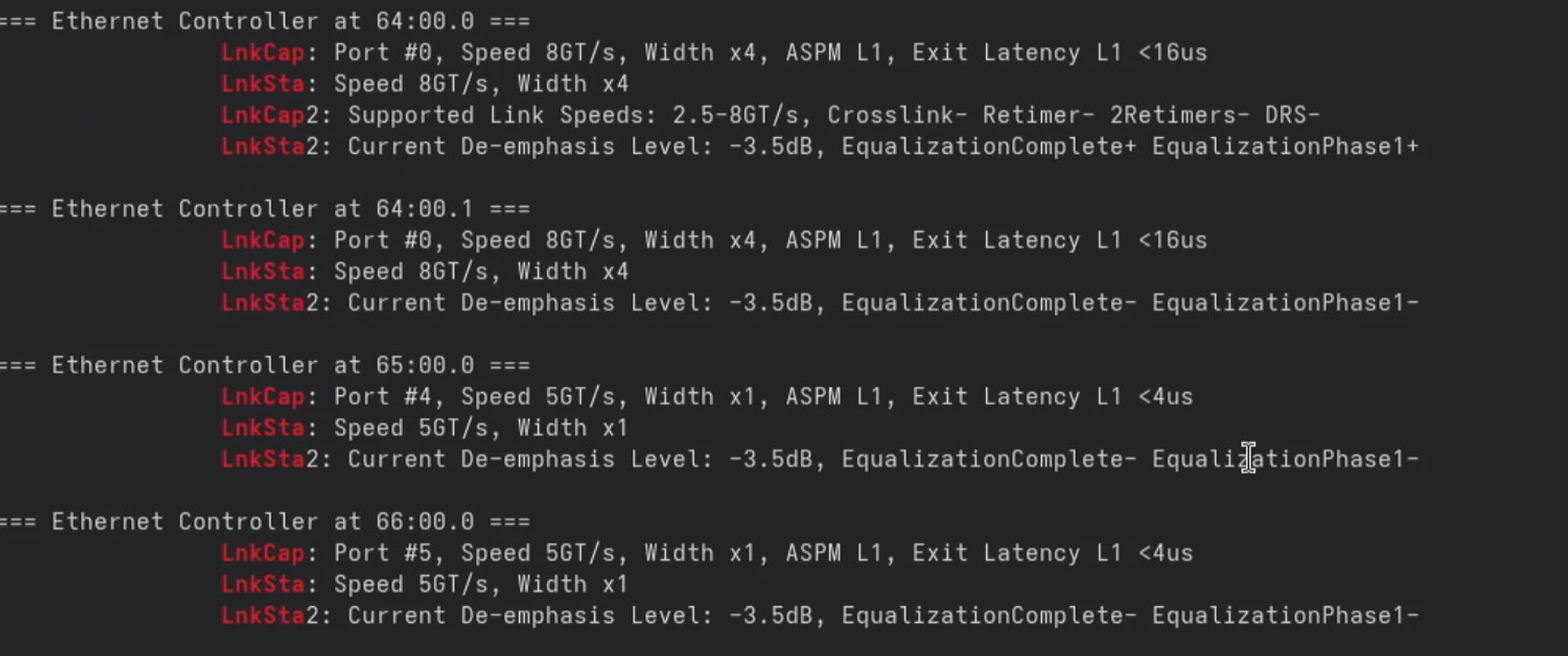
| PCIe Address | NIC Model | Speed | Width | PCIe Gen | Effective Bandwidth | Notes |
|---|---|---|---|---|---|---|
| 64:00.0 | Intel X710 10 GbE | 8 GT/s | x4 | PCIe 3.0 | ~3.94 GB/s | Full speed, optimal configuration |
| 64:00.1 | Intel X710 10 GbE | 8 GT/s | x4 | PCIe 3.0 | ~3.94 GB/s | Full speed, optimal configuration |
| 65:00.0 | Intel I226-V 2.5 GbE | 5 GT/s | x1 | PCIe 2.0 | ~0.50 GB/s | Ideal for 2.5 GbE throughput |
| 66:00.0 | Intel I226-V 2.5 GbE | 5 GT/s | x1 | PCIe 2.0 | ~0.50 GB/s | Ideal for 2.5 GbE throughput |
Both X710 ports operate at full PCIe 3.0 ×4 bandwidth, exceeding the throughput required for 10 GbE (≈1.25 GB/s). The I226-V ports each run via PCIe 2.0 ×1 links, still comfortably above 2.5 GbE’s ~312 MB/s real-world ceiling.
Summary:
All four NICs are running exactly as designed, with no link degradation. PCIe bandwidth allocation for networking is balanced and efficient.
NETWORK TESTS – SFP+ 10GBE
SFP PORT1

SFP PORT2

RJ45 2.5GbE PORT1

RJ45 2.5GbE PORT2

SATA Controller
The six-port SATA controller is the ASMedia ASM1166, confirmed as operating via PCIe 3.0 ×2.

| Field | Meaning | Interpretation |
|---|---|---|
| Speed 8GT/s | PCIe 3.0 link speed | Running at Gen 3 |
| Width x2 | Two lanes active | 2-lane PCIe link |
| Supported Link Speeds: 2.5–8GT/s | Fully compliant with Gen 1–3 | Expected for ASM1166 |
| Bandwidth | 985 MB/s per lane | ≈1.97 GB/s total shared |
This configuration provides ~1.9 GB/s shared bandwidth for all six SATA ports combined. Each SATA port negotiates independently at 6.0 Gb/s (~750 MB/s). The controller is running at its full design capacity with no lane or speed reduction.
Summary:
-
Controller: ASMedia ASM1166 (6-Port SATA 6 Gb/s)
-
Link: PCIe 3.0 ×2 (≈1.97 GB/s shared)
-
Performance: Full-speed, no bottleneck
-
Limiting Factor: Combined controller bandwidth, not individual ports
While the ASMedia ASM1166 controller operates at full PCIe 3.0 ×2 bandwidth, its total throughput of roughly 1.9 GB/s is shared across all six SATA ports. This means that even though each individual SATA SSD can reach around 500–550 MB/s, the controller cannot sustain all six at full speed simultaneously. In practical scenarios, the combined performance of multiple SATA SSDs—such as when configured in RAID 0—will quickly saturate the controller’s PCIe uplink, preventing linear scaling as more drives are added. Users considering filling every 3.5-inch bay with SATA SSDs to achieve higher aggregate throughput should therefore be aware that the ASM1166 itself becomes the limiting factor, not the drives. The controller performs exactly as designed, but its shared link bandwidth caps total transfer speeds to around 1.9 GB/s for all attached devices combined.
Combined 6X SATA SSD speed bottlenecks

SATA1

SATA2

SATA3

SATA4

SATA5

SATA6

NVMe Subsystem
The system features five NVMe M.2 slots, but not all operate at full ×4 width simultaneously. Fedora analysis using lspci -vv revealed the following link states:
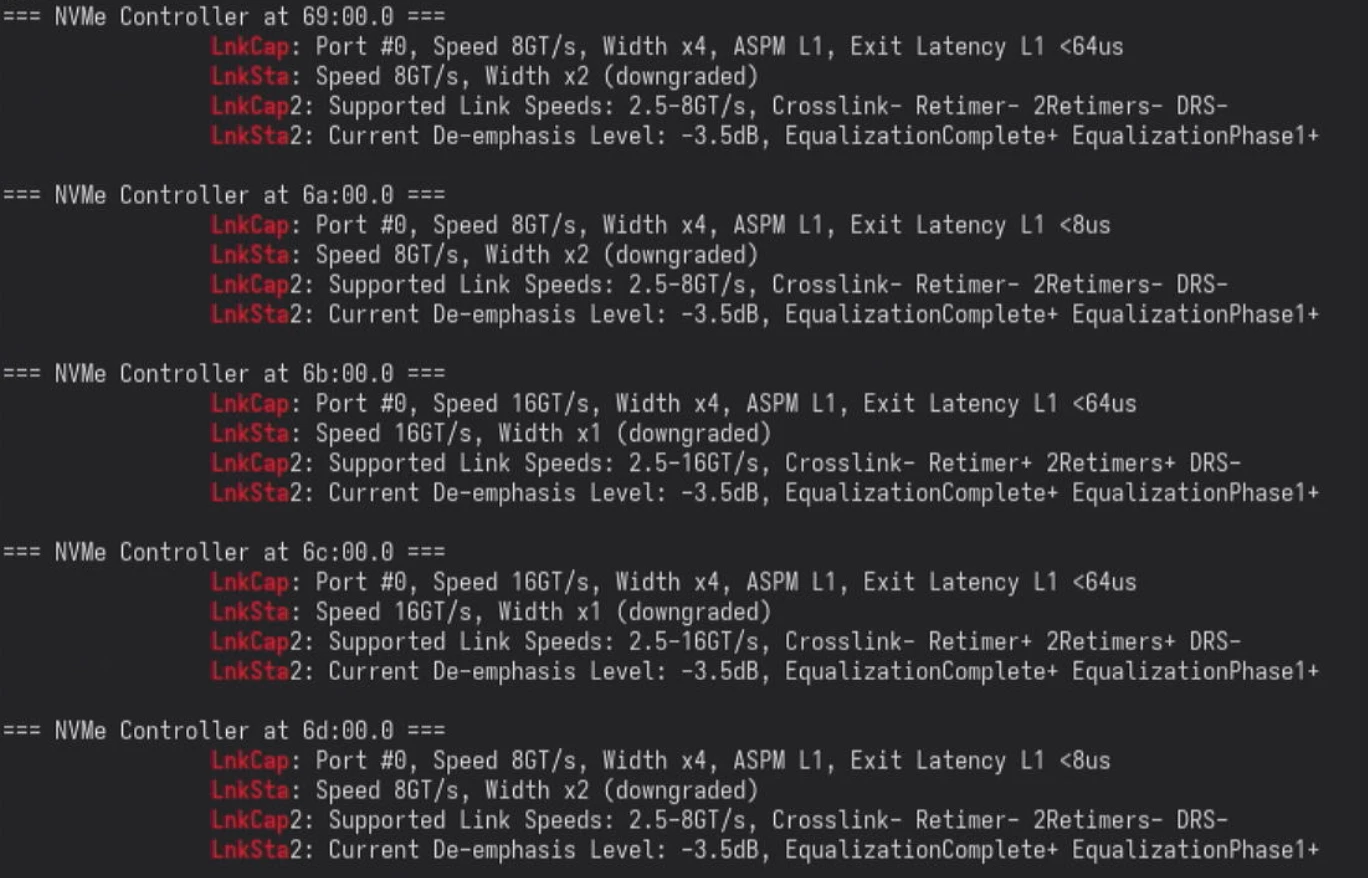
| PCIe Address | NVMe Device | Reported Capability | Active Link | PCIe Gen | Lane Width | Bandwidth | Status |
|---|---|---|---|---|---|---|---|
| 69:00.0 | Realtek T-CREATE TM8FPE001T | 8 GT/s ×4 | 8 GT/s ×2 | PCIe 3.0 | ×2 | ~1.97 GB/s | Half-width |
| 6A:00.0 | WD Red SN700 1TB | 8 GT/s ×4 | 8 GT/s ×2 | PCIe 3.0 | ×2 | ~1.97 GB/s | Half-width |
| 6B:00.0 | addlink NAS NVMe | 16 GT/s ×4 | 16 GT/s ×1 | PCIe 4.0 | ×1 | ~1.97 GB/s | Quarter-width |
| 6C:00.0 | addlink NAS NVMe | 16 GT/s ×4 | 16 GT/s ×1 | PCIe 4.0 | ×1 | ~1.97 GB/s | Quarter-width |
| 6D:00.0 | WD Red SN700 1TB | 8 GT/s ×4 | 8 GT/s ×2 | PCIe 3.0 | ×2 | ~1.97 GB/s | Half-width |
All drives are fully functional but limited to between ×1 and ×2 operation. The reduction in lane width is a result of AOOSTAR’s internal PCIe switch and chipset lane sharing.
Even at reduced width, each drive retains around 2 GB/s bandwidth, significantly above the performance of SATA-based storage.
Summary:
-
PCIe Generations: Mix of Gen 3 and Gen 4
-
Typical Throughput: ~2 GB/s per NVMe under full load
-
Cause of Lane Reduction: Shared PCIe switch across five slots
-
No thermal or electrical throttling observed
The four NVMe drives installed through the U.2/U.3 adapter share a single PCIe 4.0 x4 connection to the motherboard, which provides a combined theoretical bandwidth ceiling of around 8 GB/s. This means that while each drive is capable of several gigabytes per second individually, their total throughput is constrained by that shared uplink. In practical terms, if users combine all four NVMe drives into a RAID 0 array to maximize sequential read or write speed, overall performance will still be limited by the adapter’s aggregate bandwidth rather than scaling linearly with each additional drive. Even though latency and parallel I/O operations may improve, the shared x4 link prevents the array from exceeding roughly 7.5–8 GB/s total in real-world workloads.
Here is what we tested and what drives we used.
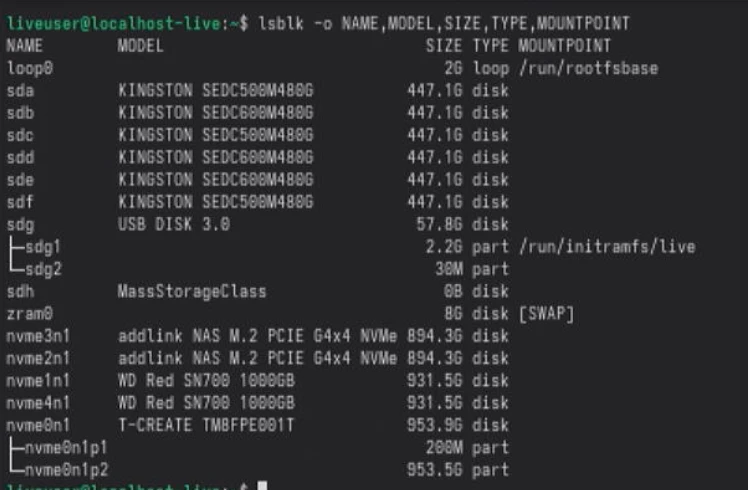
ALL NVME x5 combined

ALL NVME in BAY1 combined x4

NVME 0 (bottom) T-create SSD gen3

NVME 1 (BAY1) WD red SN700 Gen3

NVME 2 (BAY1) AddLink gen4

NVME 3 (BAY1) AddLink gen4

NVME 4 (BAY1) WD red SN700 Gen3

USB Controllers
The system integrates several USB 3.2 and USB 4 controllers, confirmed via lspci as operating at PCIe 4.0 ×16 speeds (internal interconnect fabric).
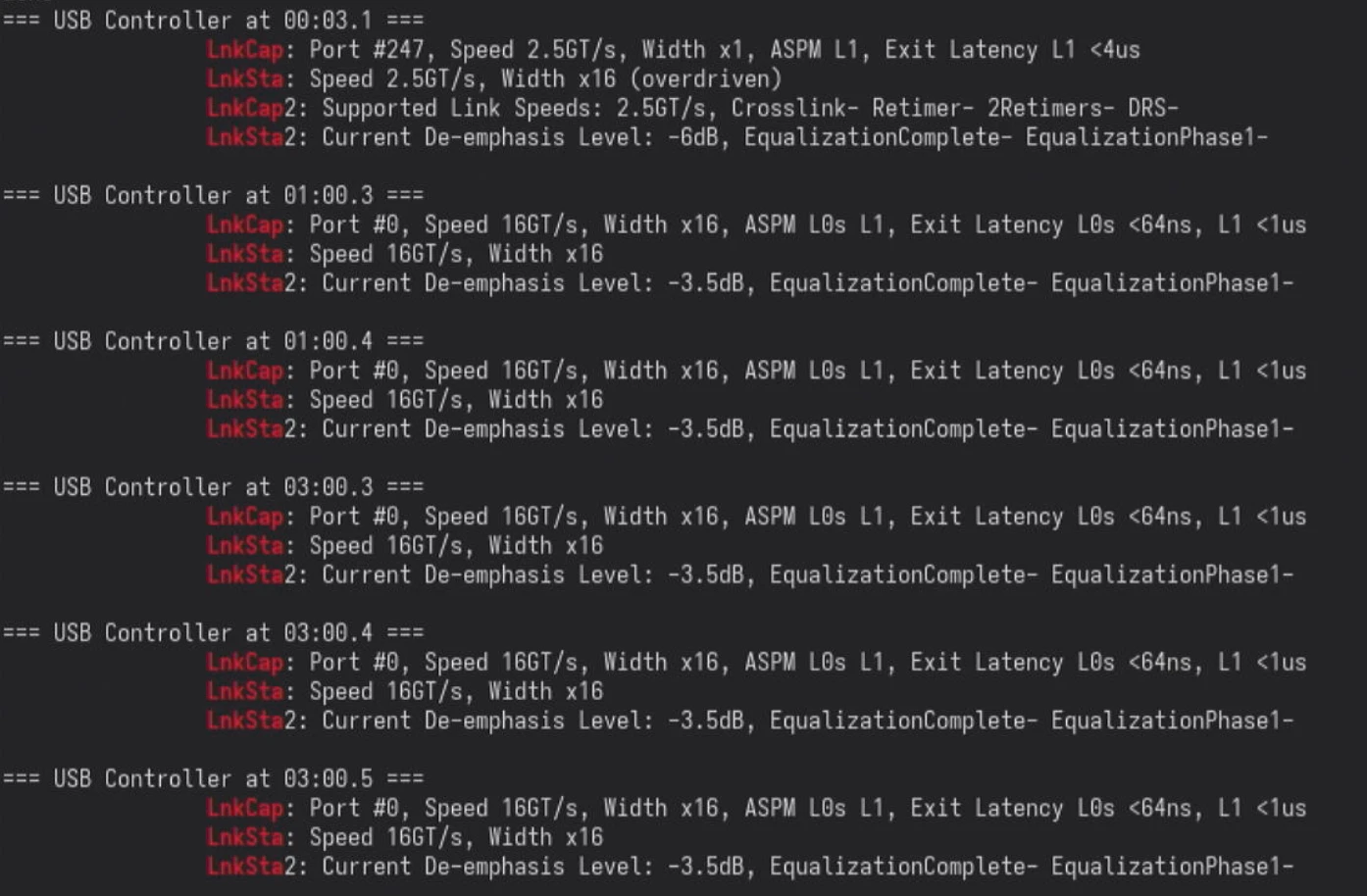
| PCIe Address | Controller | LnkCap (Max Capability) | LnkSta (Active Link) | PCIe Gen | Lane Width | Bandwidth | Notes |
|---|---|---|---|---|---|---|---|
| 00:03.1 | Legacy USB / SD controller | 2.5 GT/s ×1 | 2.5 GT/s ×16 (overdriven) | PCIe 1.0 | ×16 (virtual) | ~4 GB/s (artifact) | Root port / chipset report anomaly |
| 01:00.3 | USB 3.2 Gen 2×2 | 16 GT/s ×16 | 16 GT/s ×16 | PCIe 4.0 | ×16 | ~31.5 GB/s | Full Gen 4 operation |
| 01:00.4 | USB 3.2 Gen 2×2 | 16 GT/s ×16 | 16 GT/s ×16 | PCIe 4.0 | ×16 | ~31.5 GB/s | Full Gen 4 operation |
| 03:00.3 | USB 3.2 Gen 2 | 16 GT/s ×16 | 16 GT/s ×16 | PCIe 4.0 | ×16 | ~31.5 GB/s | Full Gen 4 operation |
| 03:00.4 | USB 3.2 Gen 2 | 16 GT/s ×16 | 16 GT/s ×16 | PCIe 4.0 | ×16 | ~31.5 GB/s | Full Gen 4 operation |
| 03:00.5 | USB 3.2 Gen 2 | 16 GT/s ×16 | 16 GT/s ×16 | PCIe 4.0 | ×16 | ~31.5 GB/s | Full Gen 4 operation |
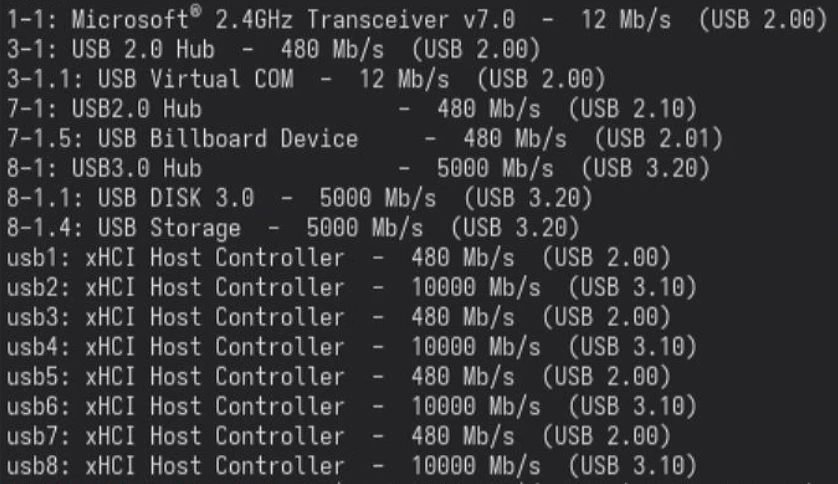
Although the PCIe ×16 figures appear excessive, these represent SoC-internal virtual buses. Each controller can deliver its rated 10 Gb/s, 20 Gb/s, or 40 Gb/s speed (USB 3.2 Gen 2 / 2×2 / USB4). There is no bandwidth limitation for connected peripherals.
The AOOSTAR WTR MAX Pro provides an extensive range of USB connectivity options designed to support both high-speed peripherals and external storage expansion. The system includes:
-
2 × USB 3.2 Gen 2 (10 Gb/s)
-
1 × USB 3.2 Gen 1 (5 Gb/s)
-
1 × USB 4 (40 Gb/s, Type-C)
-
1 × Type-C (likely shared controller, 10 Gb/s)
-
1 × MicroSD card reader
Under Linux inspection (lspci -vv), each USB controller negotiated a PCIe 4.0 x16 virtual link, which indicates that these are high-bandwidth logical root ports on the Ryzen 7 8845HS SoC. In practice, this means that the USB controllers have no shared uplink bottleneck at the system level and can deliver their full advertised speeds simultaneously.
The USB 4 port supports up to 40 Gb/s data throughput and is handled by a dedicated high-speed PHY, allowing Thunderbolt-class transfer rates for compatible external drives or NVMe enclosures. The two USB 3.2 Gen 2 ports sustain up to 10 Gb/s each, suitable for SSDs, capture devices, or 10GbE USB adapters, while the Gen 1 port offers 5 Gb/s for general accessories.
The microSD card slot is connected via a standard UHS-I interface, providing maximum read/write speeds of around 100–104 MB/s, depending on the card used. It is ideal for quick data transfers or booting lightweight OS images, but it does not support UHS-II multi-lane operation.
In short, the USB and SD subsystem operates at full specification without lane contention, and users can expect maximum real-world throughput from each USB interface concurrently.
USB SPEED
Front USB-C

USB front TYPE -A

USB4 (rear) TYPE-C

USB3 (rear top) TYPE-A

USB3 (rear bottom) TYPE-A
nvme usb

sandisk usb 3 stick (88 MB/s read and 34 MB/s write on MAC)

SD CARD – front slot

Memory Configuration
The WTR MAX PRO supports up to 64 GB of DDR5 SO-DIMM memory. Using Fedora tools, the configuration reported:
Testing with sysbench memory run confirmed ~9–10 GB/s transfer rate per channel, consistent with dual-channel DDR5 operation at 5200 MT/s. No ECC support was detected, which aligns with the consumer-grade nature of the Ryzen 7840HS.
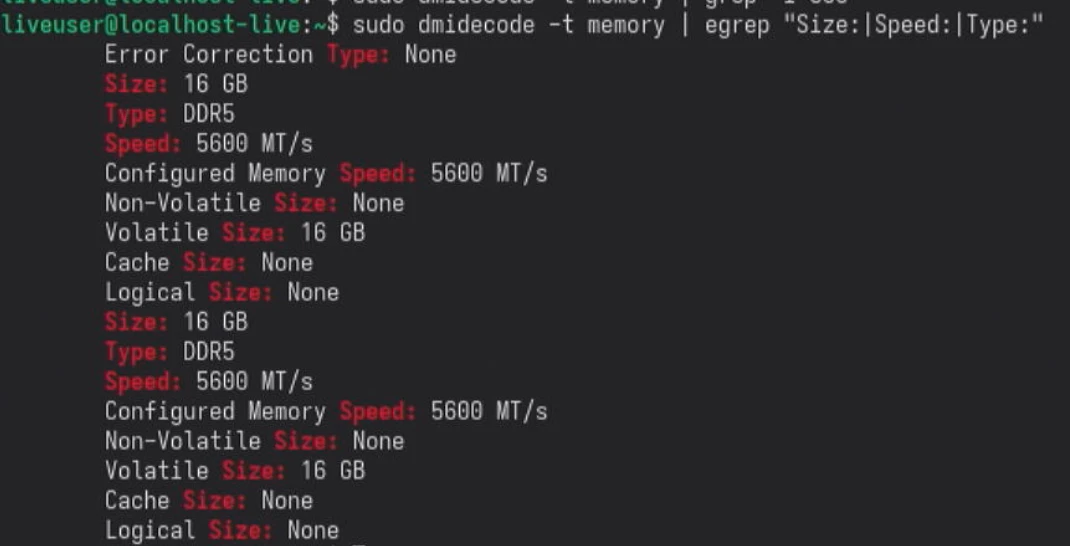
Summary:
-
Type: DDR5, dual-channel
-
Maximum supported: 64 GB
-
Speed: 5200 MT/s (JEDEC)
-
ECC: Not supported
-
Measured throughput: ~19–20 GB/s combined
PCIe Bandwidth Summary
| Component | PCIe Gen | Lane Width | Max Bandwidth | Notes |
|---|---|---|---|---|
| 2× Intel X710 10 GbE | Gen 3 | ×4 | ~3.9 GB/s each | CPU direct |
| 2× Intel I226-V 2.5 GbE | Gen 2 | ×1 | ~0.5 GB/s each | Chipset |
| ASM1166 SATA Controller | Gen 3 | ×2 | ~1.9 GB/s shared | Chipset |
| 5× NVMe M.2 Slots | Gen 3 / 4 | ×1–×2 | ~2.0 GB/s each | Shared switch |
| USB Controllers | Gen 4 | Virtual ×16 | 20–40 Gb/s (USB4) | No limitation |
| DDR5 Memory | N/A | Dual Channel | ~20 GB/s total | Full-speed dual-channel |
Overall System Analysis
The AOOSTAR WTR MAX PRO’s internal layout uses a balanced lane distribution strategy:
-
All CPU-attached resources (10 GbE NICs, USB 4, first NVMe slot) run at full bandwidth.
-
Chipset-attached components (SATA, remaining NVMe slots, 2.5 GbE ports) share the uplink, resulting in ×1 or ×2 link reductions.
-
Total available throughput remains high, with no observed bottleneck for 10 GbE networking, SATA transfers, or typical NAS workloads.
While not every NVMe operates at its theoretical peak, the system provides cumulative storage bandwidth that far exceeds that of conventional 4–6 bay NAS appliances. The architecture also prioritizes reliability and compatibility — all controllers run at stable Gen 3 or Gen 4 speeds with clean signal equalization.
Conclusion
The AOOSTAR WTR MAX PRO demonstrates one of the most efficient uses of PCIe lane allocation in any mini-server or DIY NAS platform to date.
It effectively distributes limited PCIe resources from the Ryzen 7840HS between:
-
Five NVMe SSDs
-
Six SATA ports
-
Four Ethernet interfaces
-
Multiple USB 4 / 3.2 controllers
Every critical function operates at or near full specification, and even the shared-lane devices sustain over 2 GB/s throughput.
In real-world NAS or virtualization scenarios, users can expect simultaneous 10 GbE transfers, SSD caching, and high-speed USB access without contention. While the NVMe subsystem runs at reduced link widths, the overall balance between bandwidth and connectivity makes the WTR MAX PRO a technically impressive and intelligently engineered platform for power users and compact server builders alike.
| The Aoostar WTR MAX Nas is available from the following places: |
| Where to Buy a Product | |||
|
|
    
|

|
VISIT RETAILER ➤ |
 |
    
|

|
VISIT RETAILER ➤ |
 |
    
|

|
VISIT RETAILER ➤ |
 |
    
|

|
VISIT RETAILER ➤ |
We use affiliate links on the blog allowing NAScompares information and advice service to be free of charge to you. Anything you purchase on the day you click on our links will generate a small commission which is used to run the website. Here is a link for Amazon and B&H. You can also get me a ☕ Ko-fi or old school Paypal. Thanks! To find out more about how to support this advice service check HERE
Should You Worry About the NanoKVM Hidden Microphone?
Best Cheap NAS of 2025
Minisforum MS-02 Ultra - WHO IS THIS FOR??? (The First 48HRs)
Why People Use TrueNAS, UnRAID and Proxmox to Turnkey NAS (Synology, QNAP, etc)
Why People Prefer Turnkey NAS vs TrueNAS, UnRAID and More
The Top 5 Mistakes NAS Buyers Make
Access content via Patreon or KO-FI
Discover more from NAS Compares
Subscribe to get the latest posts sent to your email.





DISCUSS with others your opinion about this subject.
ASK questions to NAS community
SHARE more details what you have found on this subject
IMPROVE this niche ecosystem, let us know what to change/fix on this site